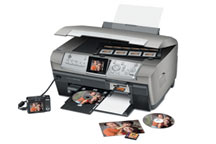Review: Epson RX700 All-In-One
For a digital photographer, buying an inkjet printer is always a complicated proposition. In the past, you had to choose between printers that delivered the photo output quality you need, and printers that provided the office functionality your business requires. Most photographers end up buying multiple printers. If you also need a scanner and a copier, and you have a small studio, you can quickly be overwhelmed by gear.
To help solve this dilemma, Epson has taken a high-quality six-color photo printing engine and stuffed it into a multifunction printer body that also includes a scanner, copier, CD/DVD printing capability, and media card slots for direct printing from flash memory cards. The result is the RX700, an excellent offering that provides photo output good enough for portfolios and samples, and office functionality that can handle your other printing needs — including some you might not know you have. The RX700 lists for $399, with a $100 mail-in rebate knocking the price down to $299.

The Epson RX700 All-In-One.
Setup
The RX700 is the size of a standard office copier: 17.7″ long x 16.4″ wide x 9.3″ high. It has a flatbed scanner on top that scans documents up to letter size. The front panel has a 2.5″ color LCD screen and several buttons for driving the printer’s standalone features. Media slots for CompactFlash, MMC, XD Picture Card, Memory Stick, Memory Stick DUO, SmartMedia and Secure Digital are also on the front, beneath a clear plastic door.
Setup is extremely simple. First, you’ll need to find the best location. Regular copier paper is fed into the front of the printer, but because it’s thicker, photo paper goes into a top-loading slot. This means you’ll need enough room above the printer to feed paper and to open the scanner’s cover. Meanwhile, CDs and DVDs have a straight-through path that goes from the front to the back of the printer using a special carrier tray. If you plan on a lot of CD/DVD printing, you’ll want easy access to the back of the printer, as well.
I stuck the RX700 on a shelf with high clearance and could easily manage its paper feeds and use the scanner platen. For CD/DVD printing, I had to swivel the printer a bit, but as I don’t print many discs, it wasn’t a terrible inconvenience. The practical upshot is that I packed an incredible amount of functionality onto a very small shelf.
The printer’s output tray sits just above the front-loading input tray. All of the paper trays can be closed to keep the printer clean and dust-free. Ink is loaded into the front of the printer, into two ink bays on either side of the paper tray.
The RX700 includes a single USB port, but as is the fashion these days, no cable. Other than power and USB, there are no other connections to make.
Overall, the RX700’s design is attractive, well-planned, and functional.
Photo Quality
For a discerning photographer, a multifunction photo printer isn’t worthwhile if its photo output is sub-par. The RX700’s six-color engine uses CMYK inks along with light cyan and light magenta. The inks are dye-based. For commercial output, most photographers these days look for pigmented inks (or dye inks with a long lifespan) and printers with more than six colors.
Most photographers also want a printer that can output larger than letter-size paper. The RX700 can’t deliver those larger commercial-quality prints, which means you still need a separate printer for commercial work. However, the RX700’s print quality is good enough to provide a lot of valuable utility.
With its 1.5-picoliter drop size and six-color engine, the RX700 does very well with fine detail and can print subtle highlight gradients without showing visible dots. It truly provides photo-quality images. But because of its engine’s relatively narrow gamut, you can’t pull out some of the deep, saturated colors possible with a higher-end photo printer.
With that said, though, you can still push and tweak images far enough that the RX700 is fine for printing representative samples. Because the RX700 quality is sufficient for most contact sheets and 4″ x 6″ examples of shots, it frees up your larger-format, higher end printer (and its more expensive consumables).
For straight office work, the RX700 is a speedy workhorse, delivering excellent text quality in black or color at up to 20 pages per minute in draft mode. It’s zippy in full-quality mode, as well.
If you ship portfolios or other assets on CD or DVD, you’ll love the RX700’s disc-printing. It’s much easier than on previous generations of Epson printers. You still need special printable discs, but these are readily available in bulk now.
To print on a disc, you insert it in a special carrier that feeds into a dedicated disc printing slot on the front of the printer. Image quality is excellent — again, much improved over earlier disc printers — and even surpasses many commercial silk-screening processes.
Epson bundles competent disc-printing software that makes it easy to create curved text and to position images properly.
Scanning
A 3200 x 6400, 48-bit color scanner is built in to the top of the RX700. Delivering very good sharpness and excellent dynamic range, you should find the scanner more than enough for office scanning. Even for many images, it may deliver all the quality you need, depending on your final print size and specs and how much editing you plan on performing.
The RX700’s scanner includes a built-in transparency attachment that’s a capable film scanner. However, note that the RX700 lacks Digital Ice technology or other built-in scratch-removal hardware, making it noticeably inferior to stand-alone scanners with such features.
Epson’s bundled EpsonScan software is excellent. It can automatically locate an image on the platen, scan it, crop it, and straighten it with a single button press.
If you mostly shoot film, you won’t want to depend on the RX700’s scanner for your livelihood, but it’s sufficient for utilitarian scanning.
Standalone Features
Surprisingly, what makes the RX700 particularly useful for a photography studio are its standalone features that don’t require a computer. Having an office copier is a great convenience, and the RX700 provides excellent color and grayscale copies with a single button press. Place a document on the scanner platen, press either the color or black and white copy button, and the RX700 scans your document and prints it. It’s not the speediest copier, and it’s not particularly economical for high-volume copies, but it’s well-suited to most copying chores.
Where the RX700’s copy functions really shine are when working with photo media. Place a photo on the platen and photo paper in the upper paper tray and you can produce excellent duplicates of printed photos without using your computer. The printer provides front-screen control of all options, including paper type, selection of bordered or borderless printing, output size, and zooming. With the Zoom feature, you can place a 3″ x 5″ print on the platen and ask the printer to deliver a 4″ x 6″ copy. It will automatically scan and scale the image to your chosen output size.
Similarly, you can place slides and negatives on the platen and output prints with a single button. The RX700’s copy mode can even copy onto printable CDs or DVDs.
It’s hard to imagine a simpler solution for quickly duplicating existing media. Yes, you can probably eke out better quality if you scan and tweak your images, but the RX700’s automatic tone and color adjustments provide a startlingly good copy of even difficult prints. I found that most copies were better if I set the RX700’s Copy Density setting down a notch, an option that’s easily configurable from the front panel.
The RX700 also provides a special Reprint/Restore Photo mode that tries to “repair” your images by performing more aggressive color and tone analysis. On a few images, this mode did yield better copies of old prints, but overall, it wasn’t especially useful.
You can also print directly from a media card by inserting it into the appropriate slot and selecting your options from the front panel controls. The RX700 provides some especially cool features for printing directly from a card. Using the bright, high-resolution LCD screen you can easily select images on the card for printing, and you can print several copies per page in a number of different configurations.
You can also print out a special contact sheet that shows thumbnails of all of the images on your card (see example below). Beneath each thumbnail are small bubbles you can fill in to indicate how many prints you want of that image. You can then stick that contact sheet on the scanner platen and the RX700 will read it, analyze your order, and start making prints.

May I take your order, please? Fill out this sheet, and the RX700 will fulfill your order. Click on this image for a larger version.
Printing out the initial contact sheet can take a while if your card contains a large number of high-resolution images, but scanning the completed form is very speedy.
Obviously, this feature is intended for consumers who want prints with as little pain as possible, but it’s also handy for the photo studio. When you have images that you regularly need to make samples of, you can tweak the files for good printing on the RX700, then store them on a media card. Then hand the card to an assistant who can take care of printing on the card without tying up a computer.
Standalone scanning features are also good, letting you scan directly to a media card, which you can then take back to your computer. Unfortunately, the RX700 can only scan into JPEG mode when scanning to a card. The option for a TIFF mode would be very welcome.
This One’s a Keeper
For serious photo output, I’ll stick with my Epson RX2400. But after using the RX700 for general office work for the last few months, it would be hard to give up. I’ve used it to deliver samples to clients, to make copies, for printing onto DVDs for client deliveries, attached it to the Mac to scan images for a black and white newsletter, and used it in standalone mode to scan images for emailing. Most of the time, I use the RX700 as a standalone device, meaning it doesn’t need to be installed near my computer.
With its very good print quality, extensive feature set, and flexible workflow options, the RX700 is a great addition to a working photography studio. And, with Epson’s current rebate, you can get the RX700 for only $299.


